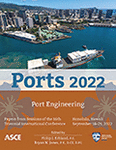Probabilistic Fragility Analysis of Reinforced Concrete Structures under Tsunami Hydrodynamic Loads of the ASCE 7 Standard
Publication: Ports 2022
ABSTRACT
Tsunamis are commonly triggered by large earthquakes along the subduction zone. The public safety risk has been mitigated by warning and evacuation planning. However, community resilience needs essential and critical structures to be structurally resistant to hazards. The ASCE/Structural Engineering Institute (ASCE/SEI) Committee has developed the new ASCE 7 tsunami loads and effects provisions. This research uses ASCE 7 provisions to evaluate the structural reliability of the critical and essential infrastructure at risk of tsunami hazards. A new structural reliability approach was developed that combines structural analysis with reliability analysis to determine the failure probability using the first-order reliability method (FORM). Adaptive pushover analysis was performed to specify structural limit states in material strain threshold values. Fragility analysis was conducted using nonlinear tsunami static and dynamic time-history analyses. Fragility curves were numerically constructed using nonlinear regression analysis for various damage states with gradually rising flood depths. The result demonstrates that expected reliabilities for tsunami hydrodynamic loads fulfill the general objective of the ASCE 7 standard. They might be used in conjunction with a probabilistic risk assessment methodology to analyze the vulnerability of typical seaport structures exposed to tsunami hazards and the United States coastal areas and other locations with similar facilities worldwide.
Get full access to this article
View all available purchase options and get full access to this chapter.
REFERENCES
Robertson, I. N., Paczkowski, K., Riggs, H. R., and Mohamed, A. (2011, January). Tsunami bore forces on walls. In International Conference on Offshore Mechanics and Arctic Engineering (Vol. 44335, pp. 395–403).
Chock, G., Yu, G., Thio, H. K., and Lynett, P. J. (2016). Target structural reliability analysis for tsunami hydrodynamic loads of the ASCE 7 standard. Journal of Structural Engineering, 142(11), 04016092.
Chock, G. (2015). The ASCE 7 tsunami loads and effects design standard for the United States. In Handbook of coastal disaster mitigation for engineers and planners (pp. 437–460). Butterworth-Heinemann.
De Risi, R., Goda, K., Yasuda, T., and Mori, N. (2017). Is flow velocity important in tsunami empirical fragility modeling? Earth-science reviews, 166, 64–82.
Moon, D. S., Lee, Y. J., and Lee, S. (2018). Fragility analysis of space reinforced concrete frame structures with structural irregularity in plan. Journal of Structural Engineering, 144(8), 04018096.
Lee, Y. J., and Moon, D. S. (2014). A new methodology of the development of seismic fragility curves. Smart Structures and Systems, 14(5), 847–867.
Melchers, R. E. (1999). Structural reliability analysis and prediction. New York: Wiley.
Der Kiureghian, A. (2005). “First-and second-order reliability methods.” Engineering design reliability handbook, edited by E. Nikolaidis, D. M. Ghiocel, and S. Singhal. Boca Raton, FL: CRC Press.
Haukaas, T., and Der Kiureghian, A. (2005). Parameter sensitivity and importance measures in nonlinear finite element reliability analysis. Journal of engineering mechanics, 131(10), 1013–1026.
McKamey, J., and Robertson, I. N. (2019). Cost Implications for Including Tsunami Design in Mid-Rise Buildings along the US Pacific Coast, University of Hawaii at Manoa, UHM/CEE/19-01.
Baiguera, M., Rossetto, T., Robertson, I., and Petrone, C. (2019, September). A nonlinear static procedure for the tsunami design of a reinforced concrete building to the ASCE7 Standard. In Proceedings of the SECED 2019 Conference: Earthquake risk and engineering towards a resilient world, (Vol. 2019). Society of Earthquake and Civil Engineering Dynamics (SECED).
Robertson, I. N. (2019). Tsunami Loads and Effects: Guide to the Tsunami Design Provisions of ASCE 7-16, ASCE Publications.
ASCE 7-22, 2022 Edition, 2022 - Minimum Design Loads and Associated Criteria for Buildings and Other Structures.
Kriebel, D. L., Lynett, P. J., Cox, D. T., Petroff, C. M., Riggs, H. R., Robertson, I. N., and Chock, G. Y. K. (2017). Energy Method for Approximating Overland Tsunami Flows. Journal of Waterway, Port, Coastal, and Ocean Engineering 143(5).
Leslie, R. (2013). The Pushover Analysis, explained in its Simplicity. RACE '13 conference, Saint Gits College of. Engineering, Kottayam, India.
Wilkinson, S., and Hiley, R. A. (2006). A non-linear response history model for the seismic analysis of high-rise framed buildings. Computers & Structures. 84. 318–329. 10.1016/j.compstruc.2005.09.021.
Bartlett, F. M., and Macgregor, J. G. (1996).“Statistical analysis of the compressive strength of concrete in structures.” ACI Mater. J.93 (2): 158–168.
Mirza, S. A., and MacGregor, J. G. (1979).“Variability of mechanical properties of reinforcing bars.” J. Struct. Div.105 (5): 921–937.
Information & Authors
Information
Published In
History
Published online: Sep 15, 2022
Authors
Metrics & Citations
Metrics
Citations
Download citation
If you have the appropriate software installed, you can download article citation data to the citation manager of your choice. Simply select your manager software from the list below and click Download.
